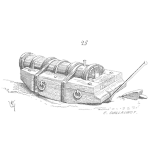
In the first part “Is the HALT a Life Test or not?” we added the test time to the HALT stress set. What does this give us for lifetime evaluation when testing one or two samples? The correct answer is nothing. But if we add knowledge of the lifetime distribution type and a shape parameter (variation), then we can work with its tails

and use a modification of the well-known formula
$$ \displaystyle 1-CL=r^{n} $$
For example, if we know that the product has a lognormal lifetime distribution and a standard deviation of 0.3, we can test two products for three lifetimes (3000 h). If there are no failures, we can be sure that the reliability of this product is R = 0.99 during T = 1000 h with CL = 0.99 (We can use Reliasoft’s Weibull++ DRT utility to calculate).
This example shows that it is sometimes useful “to pull the cat by the tail”. If you know the length of this tail.

Oleg Ivanov is an aircraft engine design engineer with experience creating accelerated tests of aviation products (auxiliary power units, turbo generators, turbopumps, and electro pumps). I see the shortcomings of standards and theory reliability/lifetime tests. My passion is to create new approaches (methods, tools) to accelerated tests. Life Cycle Simulator is one of these new tools.
Leave a Reply